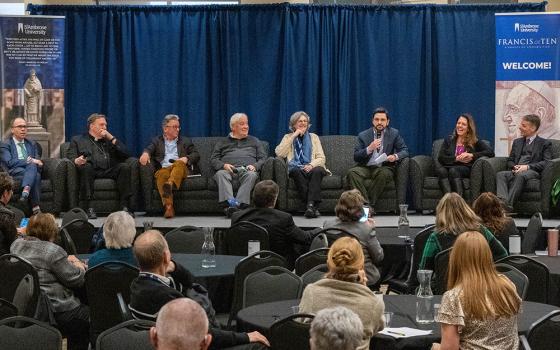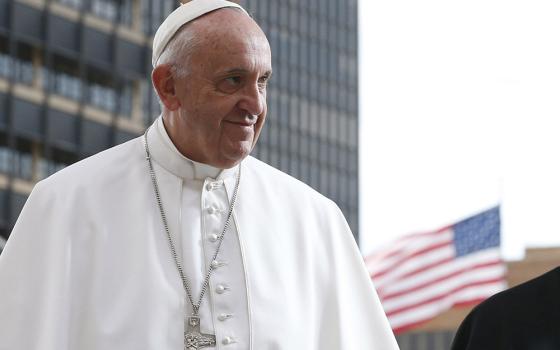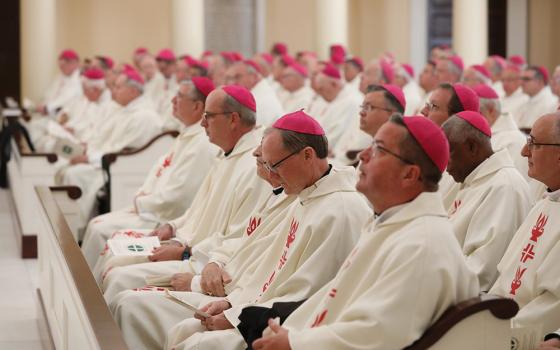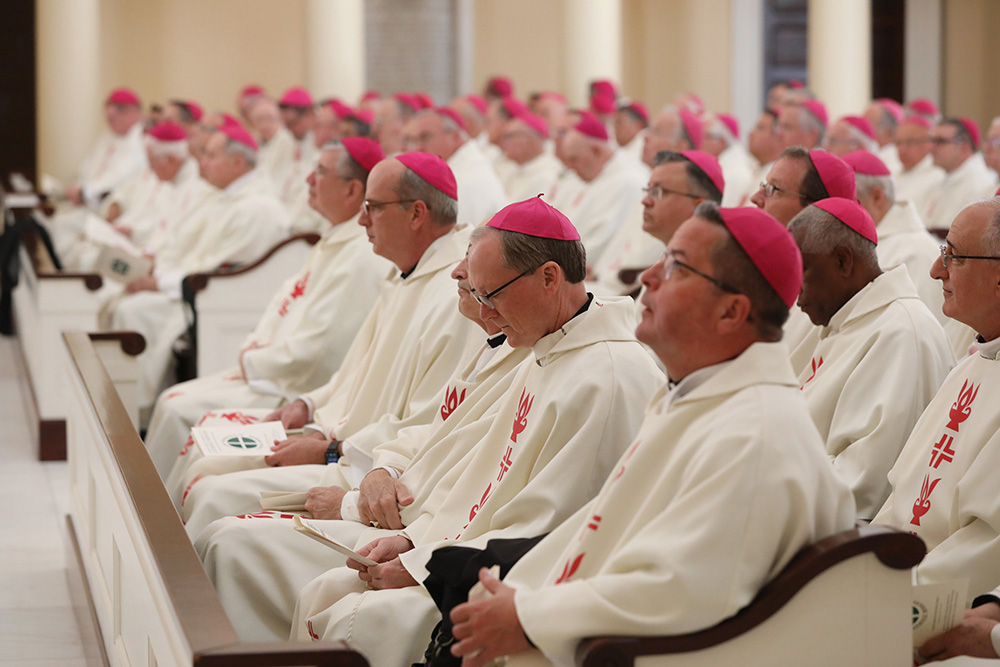
Bishops attend Mass at the Basilica of the National Shrine of the Assumption of the Blessed Virgin Mary Nov. 14, 2022, on the first day of the fall general assembly of the U.S. Conference of Catholic Bishops in Baltimore. (CNS/Bob Roller)
When will Pope Francis start making some legacy appointments in the U.S. church? When will he, and those who can help him, throw long, aim for the end zone, in naming new bishops? Those are the questions beneath the surface of my colleague Brian Fraga's article about the many dioceses and archdioceses that are coming open in the next few years.
In Canada, the pope just threw long, naming 51-year-old Bishop Francis Leo as the next archbishop of Toronto, the largest diocese in the country. Leo had only been a bishop for five months when he was named to replace Cardinal Thomas Collins. That is more than throwing long; that is placing a big bet.
In the United States, Francis has made major appointments. His 2014 decision to elevate Bishop Blase Cupich to the archbishopric of Chicago was the first that clearly indicated a new direction for the U.S. hierarchy. Cupich had long been a voice of sanity at meetings of the U.S. hierarchy, for example, opposing efforts to deny Communion to politicians based on their voting records and other culture war approaches.
Appointing Bishop Robert McElroy to San Diego the following year and transferring Archbishop Joseph Tobin from Indianapolis to Newark, New Jersey, in 2016 sent a similar signal: The pope passed over more conservative candidates and, in all three cases, sources tell me the decision was made in spite of the urgings of the apostolic nuncio at the time, Archbishop Carlo Maria Viganò.
All three appointments were also named cardinals, Cupich and Tobin in 2016 and McElroy in 2022, further demonstrating the pope's confidence in them.
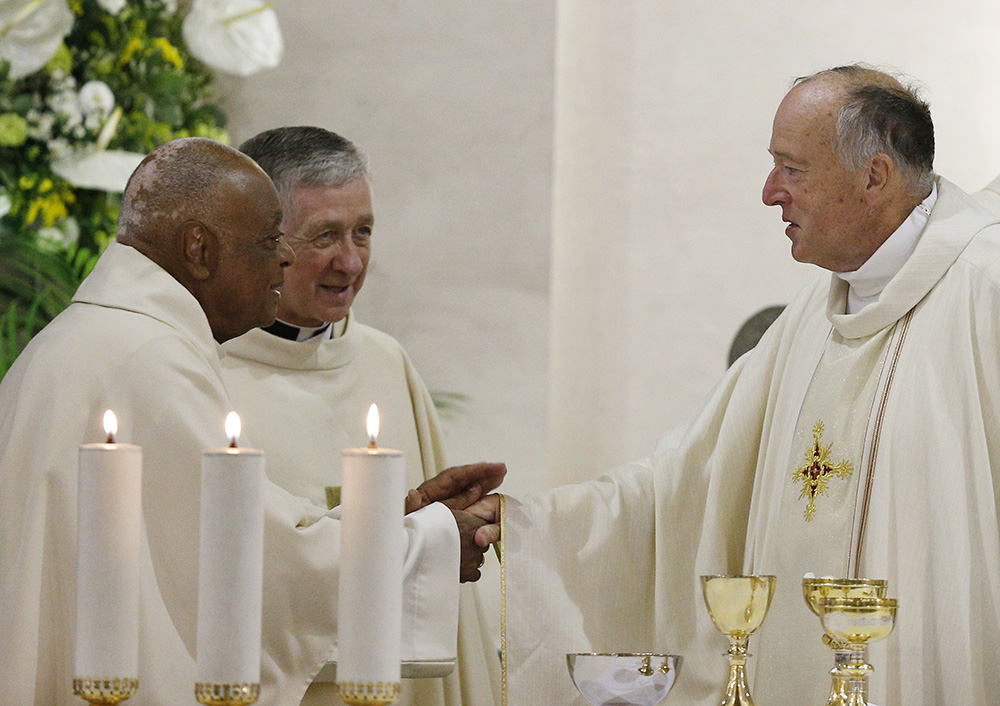
From left, Cardinals Wilton Gregory of Washington, Blase Cupich of Chicago and Robert McElroy of San Diego exchange the sign of peace during Mass at St. Patrick's Church, official home of the U.S. Catholic community in Rome, on Aug. 28, 2022. (CNS/Paul Haring)
The decision in 2019 to transfer Archbishop Paul Etienne from Anchorage, Alaska, to Seattle showed a similar determination for a different style of episcopal leadership. Retiring Archbishop Peter Sartain had requested a coadjutor and many anticipated it would be Bishop Robert Barron, a close friend of Sartain. But the pope selected Etienne, a man whose charisma matches that of the telegenic Barron, but whose ecclesiological leanings are more obviously in line with those of Francis. Etienne has never done a dog-and-pony show with Jordan Peterson, for example.
Other appointments showed the pope's desire for more pastoral, less culture-warrior prelates. Sending Archbishop Wilton Gregory to Washington in 2019, and then naming him cardinal, guaranteed there would be no showdown over denying Communion in the nation's capital.
Similarly, the appointment of Bishop Shelton Fabre last year to the venerable see of Louisville, Kentucky, indicated that same preference for pastors over bomb-throwers. And replacing Bishop Thomas Olmsted with Bishop John Dolan in the nation's fastest-growing city, Phoenix, was another great appointment.
Pope Francis has been pope for 10 years and, in an unprecedented way, many U.S, bishops refuse to get on board. It is time to turn decisively, not slowly, by selecting new bishops who are not stuck in the past.
There is an old saying in the Vatican diplomatic corps about how to remake a hierarchy in the face of opposition: "Two for us, one for them." The idea is that the church is a large ship, and people stake their souls on its practices and beliefs, so if you wish it to move in a new direction, you must turn it slowly.
Pope Francis has been pope for 10 years and, in an unprecedented way, many U.S, bishops refuse to get on board. It is time to turn decisively, not slowly, by selecting new bishops who are not stuck in the past.
Last fall, the U.S. bishops selected Archbishop Timothy Broglio as the president of the U.S. Conference of Catholic Bishops. There were a variety of reasons for the choice, and some bishops whom I think of as being very pro-Francis did not realize that they had chosen someone with a history of bad blood with Francis, nor were they aware of his sketchy connection to the late Cardinal Angelo Sodano, with all that implies.
Broglio showed his indifference to the task of uniting the conference when he published a sermon he recently delivered in Washington. In it, he contradicts McElroy without mentioning him, quoting from an article by E. Christian Brugger in The Catholic World Report. The Brugger article repeatedly misrepresented McElroy's argument, a fact Broglio ignored.
I was not surprised to find Broglio was unsympathetic toward the position staked out by McElroy, but I was surprised to find out he had found a way to be, at the same time, divisive in attacking McElroy and cowardly in not naming him. We should expect more from the president of a bishops' conference.
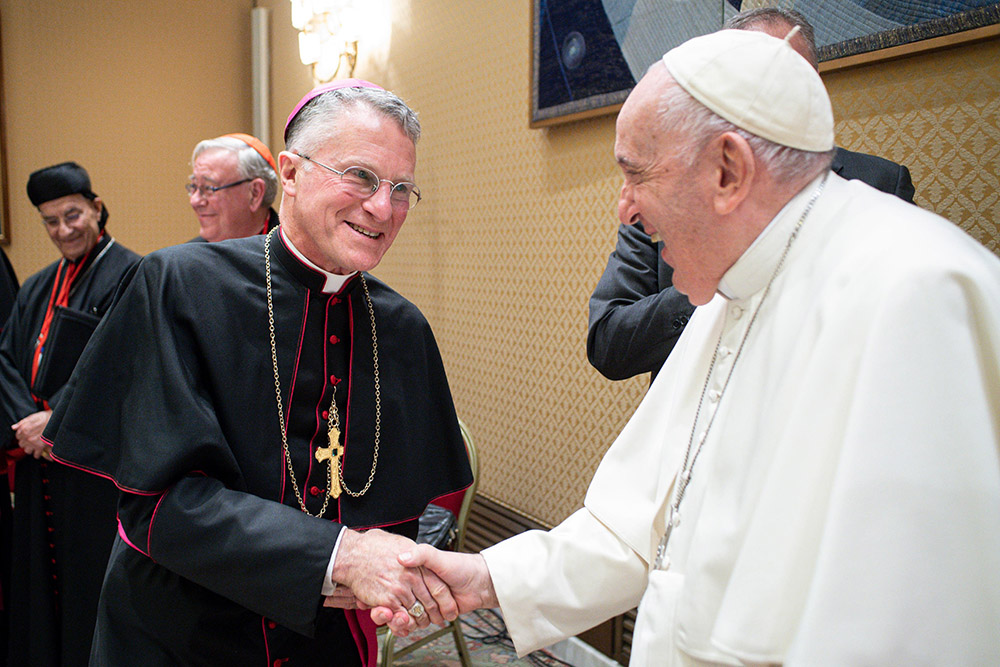
Pope Francis greets Archbishop Timothy Broglio, president of the U.S. Conference of Catholic Bishops, during a meeting with the presidents and coordinators of the regional assemblies of the Synod of Bishops at the Vatican Nov. 28, 2022. (CNS/Vatican Media)
The recent election of Archbishop Alexander Sample to the executive committee of the U.S. bishops' conference only confirms the anti-Francis sentiment of the U.S. bishops. Sample has distinguished himself mostly for his active support for the Tridentine rite, even suggesting that all seminarians should learn to perform the old rite.
Still, it was a different election at last November's meeting of U.S. bishops that showed why the nuncio, the Dicastery for Bishops and the pope himself must really scrutinize their candidates for the episcopacy carefully, and be willing to take some risks.
In selecting a new secretary for the conference, the bishops last year chose Oklahoma City Archbishop Paul Coakley — who had issued a statement of support for Viganò when Viganò called for the pope to resign — over Tobin by margin of 130-104. Coakley has never retracted his encomium to the now-disgraced former nuncio. He is also the "ecclesiastical adviser" to Tim Busch's Napa Institute, the place where Catholic social teaching goes to die. Yet Coakley beat Tobin by 26 votes.
Twenty-six votes need to be flipped within the next three years so that, in 2025, the U.S. bishops can select a new president who is committed to that most basic understanding of Catholic ecclesial life: The unity of the Roman Catholic Church is founded on communion with the bishop of Rome. Period.
That is why for the next few years the motto cannot be "two for us, one for them." Now it must be "30 for us, nothing for them."





